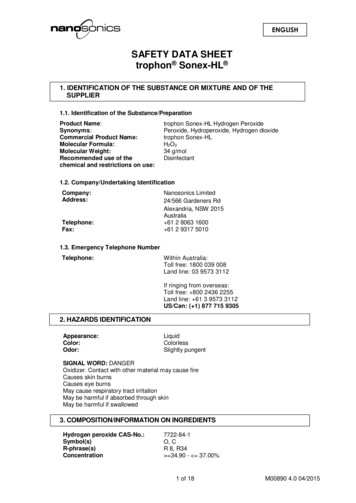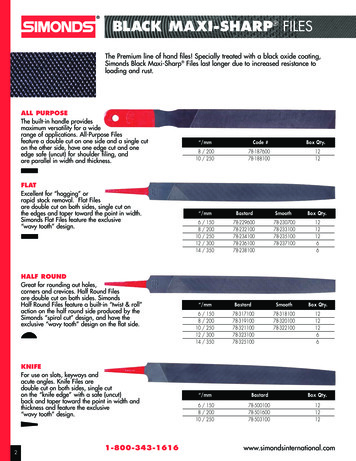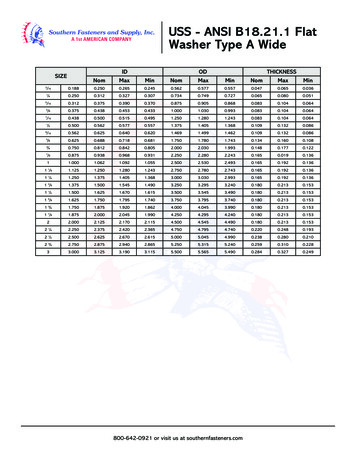
Transcription
Search engines have two major functions: crawling andbuilding an index, and providing search users with a ranked listof the websites they've determined are the most relevant.Imagine the World Wide Web as a network of stops in a big city subwaysystem.Each stop is a unique document (usually a web page, but sometimes a PDF, JPG, or otherfile). The search engines need a way to “crawl” the entire city and find all the stops along theway, so they use the best path available—links.The link structure of the web serves to bind all of the pages together.Links allow the search engines' automated robots, called "crawlers" or "spiders," to reach themany billions of interconnected documents on the web.Once the engines find these pages, they decipher the code from them and store selectedpieces in massive databases, to be recalled later when needed for a search query. Toaccomplish the monumental task of holding billions of pages that can be accessed in afraction of a second, the search engine companies have constructed datacenters all over theworld.These monstrous storage facilities hold thousands of machines processing large quantities ofinformation very quickly. When a person performs a search at any of the major engines, theydemand results instantaneously; even a one- or two-second delay can cause dissatisfaction,so the engines work hard to provide answers as fast as possible.1.Crawling and Indexing2.Providing AnswersCrawling and indexing the billions ofdocuments, pages, files, news,videos, and media on the World WideWeb.Providing answers to user queries,most frequently through lists ofrelevant pages that they've retrievedand ranked for relevancy.
Search engines are answer machines. When a person performs an online search, the searchengine scours its corpus of billions of documents and does two things: first, it returns onlythose results that are relevant or useful to the searcher's query; second, it ranks those resultsaccording to the popularity of the websites serving the information. It is both relevance andpopularity that the process of SEO is meant to influence.How do search engines determine relevance and popularity?To a search engine, relevance means more than finding a page with the right words. In theearly days of the web, search engines didn’t go much further than this simplistic step, andsearch results were of limited value. Over the years, smart engineers have devised better waysto match results to searchers’ queries. Today, hundreds of factors influence relevance, andwe’ll discuss the most important of these in this guide.Search engines typically assume that the more popular a site, page, or document, the morevaluable the information it contains must be. This assumption has proven fairly successful interms of user satisfaction with search results.Popularity and relevance aren’t determined manually. Instead, the engines employmathematical equations (algorithms) to sort the wheat from the chaff (relevance), and then torank the wheat in order of quality (popularity).These algorithms often comprise hundreds of variables. In the search marketing field, we referto them as “ranking factors.” Moz crafted a resource specifically on this subject: SearchEngine Ranking Factors.You can surmise that search enginesbelieve that Ohio State is the mostrelevant and popular page for thequery “Universities” while the page forHarvard is less relevant/popular.How Do I Get Some Success Rolling In?Or, "how search marketers succeed"The complicated algorithms of search engines may seem impenetrable. Indeed, the enginesthemselves provide little insight into how to achieve better results or garner more traffic. What theydo provide us about optimization and best practices is described below:SEO INFORMATION FROMGOOGLE WEBMASTERGUIDELINESGoogle recommends the following to get better rankings intheir search engine:Make pages primarily for users, not for search engines.Don't deceive your users or present different content tosearch engines than you display to users, a practicecommonly referred to as "cloaking."Make a site with a clear hierarchy and text links. Every pageshould be reachable from at least one static text link.
Create a useful, information-rich site, and write pages thatclearly and accurately describe your content. Make sure thatyour title elements and ALT attributes are descriptive andaccurate.Use keywords to create descriptive, human-friendly URLs.Provide one version of a URL to reach a document, using301 redirects or the rel "canonical" attribute to addressduplicate content.SEO INFORMATION FROM BINGWEBMASTER GUIDELINESBing engineers at Microsoft recommend the following to getbetter rankings in their search engine:Ensure a clean, keyword rich URL structure is in place.Make sure content is not buried inside rich media (AdobeFlash Player, JavaScript, Ajax) and verify that rich mediadoesn't hide links from crawlers.Create keyword-rich content and match keywords to whatusers are searching for. Produce fresh content regularly.Don’t put the text that you want indexed inside images. Forexample, if you want your company name or address to beindexed, make sure it is not displayed inside a companylogo.Have No Fear, Fellow Search Marketer!In addition to this freely-given advice, over the 15 years thatweb search has existed, search marketers have found methodsto extract information about how the search engines rankpages. SEOs and marketers use that data to help their sites andtheir clients achieve better positioning.Surprisingly, the engines support many of these efforts, though the public visibility isfrequently low. Conferences on search marketing, such as the Search Marketing Expo,Pubcon, Search Engine Strategies, Distilled, and Moz’s own MozCon attract engineers andrepresentatives from all of the major engines. Search representatives also assist webmastersby occasionally participating online in blogs, forums, and groups.There is perhaps no greater tool available to webmasters researching the activities of the engines than the freedom to use the search enginesthemselves to perform experiments, test hypotheses, and form opinions. It is through this iterative—sometimes painstaking—process that aconsiderable amount of knowledge about the functions of the engines has been gleaned. Some of the experiments we’ve tried go somethinglike this:1.2.Register a new website with nonsense keywords (e.g.,5.Record the rankings of the pages in search engines.ishkabibbell.com).6.Now make small alterations to the pages and assess theirCreate multiple pages on that website, all targeting aimpact on search results to determine what factors mightsimilarly ludicrous term (e.g., yoogewgally).push a result up or down against its peers.
3.4.Make the pages as close to identical as possible, then alter7.Record any results that appear to be effective, and re-testone variable at a time, experimenting with placement ofthem on other domains or with other terms. If several teststext, formatting, use of keywords, link structures, etc.consistently return the same results, chances are you’vePoint links at the domain from indexed, well-crawled pagesdiscovered a pattern that is used by the search engines.on other domains.An Example Test We PerformedIn our test, we started with the hypothesis that a link earlier (higher up) on a page carries moreweight than a link lower down on the page. We tested this by creating a nonsense domainwith a home page with links to three remote pages that all have the same nonsense wordappearing exactly once on the page. After the search engines crawled the pages, we foundthat the page with the earliest link on the home page ranked first.This process is useful, but is not alone in helping to educate searchmarketers.In addition to this kind of testing, search marketers can also glean competitive intelligenceabout how the search engines work through patent applications made by the major engines tothe United States Patent Office. Perhaps the most famous among these is the system thatgave rise to Google in the Stanford dormitories during the late 1990s, PageRank, documentedas Patent #6285999: "Method for node ranking in a linked database." The original paper onthe subject – Anatomy of a Large-Scale Hypertextual Web Search Engine – has also been thesubject of considerable study. But don't worry; you don't have to go back and take remedialcalculus in order to practice SEO!Through methods like patent analysis, experiments, and livetesting, search marketers as a community have come tounderstand many of the basic operations of search engines andthe critical components of creating websites and pages thatearn high rankings and significant traffic.The rest of this guide is devoted to clearly these insights. Enjoy!
One of the most important elements to building an onlinemarketing strategy around SEO is empathy for your audience.Once you grasp what your target market is looking for, you canmore effectively reach and keep those users.How people use search engines hasevolved over the years, but theprimary principles of conducting asearch remain largely unchanged.Most search processes go somethinglike this:1.Experience the need for an answer,solution, or piece of information.2.Formulate that need in a string of wordsand phrases, also known as “the query.”We like to say, "Build for users, not for search engines." There are three types of searchqueries people generally make:3.Enter the query into a search engine.4.Browse through the results for a match.5.Click on a result.6.Scan for a solution, or a link to that"Do" Transactional Queries: I want to do something, such as buy a plane ticket or listen to asong."Know" Informational Queries: I need information, such as the name of a band or the bestrestaurant in New York City."Go" Navigation Queries: I want to go to a particular place on the Intrernet, such as Facebooksolution.or the homepage of the NFL.When visitors type a query into a search box and land on your site, will they be satisfied withwhat they find? This is the primary question that search engines try to answer billions of timeseach day. The search engines' primary responsibility is to serve relevant results to their7.and browse for another link or .users. So ask yourself what your target customers are looking for and make sure your sitedelivers it to them.It all starts with words typed into a small box.If unsatisfied, return to the search results8.Perform a new search with refinements tothe query.The True Power of Inbound Marketing with SEOWhy should you invest time, effort, and resources on SEO? When looking at the broad pictureof search engine usage, fascinating data is available from several studies. We've extractedthose that are recent, relevant, and valuable, not only for understanding how users search, butto help present a compelling argument about the power of SEO.
Google leads the way in an October 2011 study bycomScore:Google led the U.S. core search market in April with 65.4percent of the searches conducted, followed by Yahoo! with17.2 percent, and Microsoft with 13.4 percent. (Microsoftpowers Yahoo Search. In the real world, most webmasters see amuch higher percentage of their traffic from Google than thesenumbers suggest.)Americans alone conducted a staggering 20.3 billion searchesin one month. Google accounted for 13.4 billion searches,followed by Yahoo! (3.3 billion), Microsoft (2.7 billion), AskNetwork (518 million), and AOL LLC (277 million).Total search powered by Google properties equaled 67.7percent of all search queries, followed by Bing which powered26.7 percent of all search.An August 2011 Pew Internet study revealed:The percentage of Internet users who use search engines on atypical day has been steadily rising from about one-third of allusers in 2002, to a new high of 59% of all adult Internet users.With this increase, the number of those using a search engineon a typical day is pulling ever closer to the 61 percent ofInternet users who use e-mail, arguably the Internet's all-timekiller app, on a typical day.viewStatCounter Global Stats reports the top 5 searchengines sending traffic worldwide:Google sends 90.62% of traffic.Yahoo! sends 3.78% of traffic.Bing sends 3.72% of traffic.viewBillions spent on online marketing from an August2011 Forrester report:Ask Jeeves sends .36% of traffic.Baidu sends .35% of traffic.Online marketing costs will approach 77 billion in 2016.This amount will represent 26% of all advertising budgetscombined.viewSearch is the new Yellow Pages from a Burke 2011report:76% of respondents used search engines to find local businessinformation vs. 74% who turned to print yellow pages.67% had used search engines in the past 30 days to find localinformation, and 23% responded that they had used onlinesocial networks as a local media source.viewAll of this impressive research data leads us to importantconclusions about web search and marketing through searchengines. In particular, we're able to make the following statements:Search is very, very popular. Growing strong at nearly 20% ayear, it reaches nearly every online American, and billions ofpeople around the world.Search drives an incredible amount of both online and offlineeconomic activity.Higher rankings in the first few results are critical to visibility.Being listed at the top of the results not only provides thegreatest amount of traffic, but also instills trust in consumers asto the worthiness and relative importance of the company orwebsite.Learning the foundations of SEO is a vital step in achieving theseviewA 2011 study by Slingshot SEO reveals click-throughrates for top rankings:A #1 position in Google's search results receives 18.2% of allclick-through traffic.The second position receives 10.1%, the third 7.2%, the fourth4.8%, and all others under 2%.A #1 position in Bing's search results averages a 9.66% clickthrough rate.The total average click-through rate for first ten results was52.32% for Google and 26.32% for Bing.view"For marketers, the Internet as a whole, andsearch in particular, are among the mostimportant ways to reach consumers andbuild a business."
goals.
An important aspect of SEO is making your website easy forboth users and search engine robots to understand. Althoughsearch engines have become increasingly sophisticated, theystill can't see and understand a web page the same way ahuman can. SEO helps the engines figure out what each page isabout, and how it may be useful for users.A Common Argument Against SEOWe frequently hear statements like this:"No smart engineer would ever build a search engine that requires websites to follow certainrules or principles in order to be ranked or indexed. Anyone with half a brain would want asystem that can crawl through any architecture, parse any amount of complex or imperfectcode, and still find a way to return the most relevant results, not the ones that have been'optimized' by unlicensed search marketing experts."But Wait .Imagine you posted online a picture of your family dog. A human might describe it as "a black,medium-sized dog, looks like a Lab, playing fetch in the park." On the other hand, the bestsearch engine in the world would struggle to understand the photo at anywhere near that levelof sophistication. How do you make a search engine understand a photograph? Fortunately,SEO allows webmasters to provide clues that the engines can use to understand content. Infact, adding proper structure to your content is essential to SEO.Understanding both the abilities and limitations of search engines allows you to properly build,format, and annotate your web content in a way that search engines can digest. Without SEO,a website can be invisible to search engines.The Limits of Search Engine TechnologyThe major search engines all operate on the same principles, as explained in Chapter 1. Automated search bots crawl the web, follow links,and index content in massive databases. They accomplish this with dazzling artificial intelligence, but modern search technology is not allpowerful. There are numerous technical limitations that cause significant problems in both inclusion and rankings. We've listed the mostcommon below:Problems Crawling and IndexingOnline forms: Search engines aren't good at completing onlineforms (such as a login), and thus any content contained behindthem may remain hidden.Duplicate pages: Websites using a CMS (Content ManagementSystem) often create duplicate versions of the same page; thisis a major problem for search engines looking for completelyoriginal content.Blocked in the code: Errors in a website's crawling directives(robots.txt) may lead to blocking search engines entirely.Problems Matching Queries toContentUncommon terms: Text that is not written in the commonterms that people use to search. For example, writing about"food cooling units" when people actually search for"refrigerators."Language and internationalization subtleties: For example,"color" vs. "colour." When in doubt, check what people aresearching for and use exact matches in your content.Incongruous location targeting: Targeting content in Polish
Poor link structures: If a website's link structure isn'tunderstandable to the search engines, they may not reach all ofa website's content; or, if it is crawled, the minimally-exposedcontent may be deemed unimportant by the engine's index.Non-text Content: Although the engines are getting better atreading non-HTML text, content in rich media format is stilldifficult for search engines to parse. This includes text in Flashfiles, images, photos, video, audio, and plug-in content.when the majority of the people who would visit your websiteare from Japan.Mixed contextual signals: For example, the title of your blogpost is "Mexico's Best Coffee" but the post itself is about avacation resort in Canada which happens to serve great coffee.These mixed messages send confusing signals to searchengines.Make sure your content gets seenGetting the technical details of search engine-friendly web development correct is important, butonce the basics are covered, you must also market your content. The engines by themselveshave no formulas to gauge the quality of content on the web. Instead, search technology relies onthe metrics of relevance and importance, and they measure those metrics by tracking whatpeople do: what they discover, react, comment, and link to. So, you can’t just build a perfectwebsite and write great content; you also have to get that content shared and talked about.Take a look at any search results page and you'll find the answer to why search marketinghas a long, healthy life ahead.There are, on average, ten positions on the search results page. The pages that fill those positions areordered by rank. The higher your page is on the search results page, the better your click-throughrate and ability to attract searchers. Results in positions 1, 2, and 3 receive much more traffic thanresults down the page, and considerably more than results on deeper pages. The fact that so muchattention goes to so few listings means that there will always be a financial incentive for searchengine rankings. No matter how search may change in the future, websites and businesses willcompete with one another for this attention, and for the user traffic and brand visibility it provides.
Constantly Changing SEOWhen search marketing began in the mid-1990s, manualsubmission, the meta keywords tag, and keyword stuffing were allregular parts of the tactics necessary to rank well. In 2004, linkbombing with anchor text, buying hordes of links from automatedblog comment spam injectors, and the construction of inter-linkingfarms of websites could all be leveraged for traffic. In 2011, socialmedia marketing and vertical search inclusion are mainstreammethods for conducting search engine optimization. The searchengines have refined their algorithms along with this evolution, somany of the tactics that worked in 2004 can hurt your SEO today.The future is uncertain, but in the world of search, change is aconstant. For this reason, search marketing will continue to be apriority for those who wish to remain competitive on the web.Some have claimed that SEO is dead, or that SEO amounts tospam. As we see it, there's no need for a defense other thansimple logic: websites compete for attention and placement inthe search engines, and those with the knowledge andexperience to improve their website's ranking will receive thebenefits of increased traffic and visibility.
Search engines are limited in how they crawl the web andinterpret content. A webpage doesn't always look the same toyou and me as it looks to a search engine. In this section, we'llfocus on specific technical aspects of building (or modifying)web pages so they are structured for both search engines andhuman visitors alike. Share this part of the guide with yourprogrammers, information architects, and designers, so that allparties involved in a site's construction are on the same page.Indexable ContentTo perform better in search engine listings, your most important content should be in HTMLtext format. Images, Flash files, Java applets, and other non-text content are often ignored ordevalued by search engine crawlers, despite advances in crawling technology. The easiestway to ensure that the words and phrases you display to your visitors are visible to searchengines is to place them in the HTML text on the page. However, more advanced methods areavailable for those who demand greater formatting or visual display styles:1.Provide alt text for images. Assign3.images in gif, jpg, or png format "altattributes" in HTML to give searchengines a text description of the visualwith text on the page.4.content.2.Supplement Flash or Java plug-insSupplement search boxes withProvide a transscript for video andaudio content if the words and phrasesused are meant to be indexed by theengines.navigation and crawlable links.Seeing your site as the search engines doMany websites have significant problems with indexable content, so double-checking isworthwhile. By using tools like Google's cache, SEO-browser.com, and the MozBar you cansee what elements of your content are visible and indexable to the engines. Take a look atGoogle's text cache of this page you are reading now. See how different it looks?"I have a problem with gettingfound. I built a huge Flash sitefor juggling pandas and I'mnot showing up anywhere onGoogle. What's up?"
Whoa! That's what we look like?Using the Google cache feature, we can see that to a search engine, JugglingPandas.com's homepage doesn't contain all the rich information that we see.This makes it difficult for search engines to interpret relevancy.Hey, where did the fun go?Uh oh . via Google cache, we can see that the page is a barren wasteland. There's not even text telling us that the page contains the Axe Battling Monkeys.The site is built entirely in Flash, but sadly, this means that search engines cannot index any of the text content, or even the links to the individual games.Without any HTML text, this page would have a very hard time ranking in search results.It's wise to not only check for text content but to also use SEO tools to double-check that the pages you're building are visible to the engines. This applies toyour images, and as we see below, to your links as well.Crawlable Link StructuresJust as search engines need to see content in order to list pages intheir massive keyword-based indexes, they also need to see linksin order to find the content in the first place. A crawlable linkstructure—one that lets the crawlers browse the pathways of awebsite—is vital to them finding all of the pages on a website.Hundreds of thousands of sites make the critical mistake ofstructuring their navigation in ways that search engines cannotaccess, hindering their ability to get pages listed in the searchengines' indexes.Below, we've illustrated how this problem can happen:In the example above, Google's crawler has reached page A and
sees links to pages B and E. However, even though C and D mightbe important pages on the site, the crawler has no way to reachthem (or even know they exist). This is because no direct,crawlable links point pages C and D. As far as Google can see,they don't exist! Great content, good keyword targeting, and smartmarketing won't make any difference if the crawlers can't reachyour pages in the first place.Link tags can contain images, text, or other objects, all of which provide a clickable area on the page that users can engage to move toanother page. These links are the original navigational elements of the Internet – known as hyperlinks. In the above illustration, the " a"tag indicates the start of a link. The link referral location tells the browser (and the search engines) where the link points. In this example,the URL http://www.jonwye.com is referenced. Next, the visible portion of the link for visitors, called anchor text in the SEO world,describes the page the link points to. The linked-to page is about custom belts made by Jon Wye, thus the anchor text "Jon Wye's CustomDesigned Belts." The " /a " tag closes the link to constrain the linked text between the tags and prevent the link from encompassing otherelements on the page.This is the most basic format of a link, and it is eminently understandable to the search engines. The crawlers know that they should addthis link to the engines' link graph of the web, use it to calculate query-independent variables (like Google's PageRank), and follow it toindex the contents of the referenced page.Submission-required formsRobots don't use search formsIf you require users to complete an online form before accessingcertain content, chances are search engines will never see thoseprotected pages. Forms can include a password-protected login ora full-blown survey. In either case, search crawlers generally willnot attempt to submit forms, so any content or links that would beaccessible via a form are invisible to the engines.Although this relates directly to the above warning on forms, it'ssuch a common problem that it bears mentioning. Somewebmasters believe if they place a search box on their site, thenengines will be able to find everything that visitors search for.Unfortunately, crawlers don't perform searches to find content,leaving millions of pages inaccessible and doomed to anonymityuntil a crawled page links to them.Links in unparseable JavaScriptIf you use JavaScript for links, you may find that search enginesLinks in Flash, Java, and other plug-ins
either do not crawl or give very little weight to the links embeddedwithin. Standard HTML links should replace JavaScript (oraccompany it) on any page you'd like crawlers to crawl.Links pointing to pages blocked by the Meta Robotstag or robots.txtThe Meta Robots tag and the robots.txt file both allow a site ownerto restrict crawler access to a page. Just be warned that many awebmaster has unintentionally used these directives as an attemptto block access by rogue bots, only to discover that searchengines cease their crawl.Frames or iframesThe links embedded inside the Juggling Panda site (from ourabove example) are perfect illustrations of this phenomenon.Although dozens of pandas are listed and linked to on the page, nocrawler can reach them through the site's link structure, renderingthem invisible to the engines and hidden from users' searchqueries.Links on pages with many hundreds or thousands oflinksSearch engines will only crawl so many links on a given page. Thisrestriction is necessary to cut down on spam and conserverankings. Pages with hundreds of links on them are at risk of notgetting all of those links crawled and indexed.Technically, links in both frames and iframes are crawlable, butboth present structural issues for the engines in terms oforganization and following. Unless you're an advanced user with agood technical understanding of how search engines index andfollow links in frames, it's best to stay away from them.GoogleRel "nofollow" can be used with the following syntax: a href "http://moz.com" rel "nofollow" Lousy Punks! /a Links can have lots of attributes. The engines ignore nearly all of them, with the importantexception of the rel "nofollow" attribute. In the example above, adding the rel "nofollow"attribute to the link tag tells the search engines that the site owners do not want this link to beinterpreted as an endorsement of the target page.Nofollow, taken literally, instructs search engines to not follow a link (although some do). Thenofollow tag came about as a method to help stop automated blog comment, guest book,and link injection spam (read more about the launch here), but has morphed over time into away of telling the engines to discount any link value that would ordinarily be passed. Linkstagged with nofollow are interpreted slightly differently by each of the engines, but it is clearthey do not pass as much weight as normal links.Are nofollow links bad?Although they don't pass as much value as their followed cousins, nofollowed links are anatural part of a diverse link profile. A website with lots of inbound links will accumulate manynofollowed links, and this isn't a bad thing. In fact, Moz's Ranking Factors showed that highranking sites tended to have a higher percentage of inbound nofollow links than lower-rankingsites.Google states that in most cases, theydon't follow nofollow links, nor dothese links transfer PageRank oranchor text values. Essentially, usingnofollow causes Google to drop thetarget links from their overall graphof the web. Nofollow links carry noweight and are interpreted as HTMLtext (as though the link did not exist).That said, many webmasters believethat even a nofollow link from a highauthority site, such as Wikipedia,could be interpreted as a sign of trust.Bing & Yahoo!Bing, which powers Yahoo searchresults, has also stated that they donot include nofollow links in the linkgraph, though their crawlers may stilluse nofoll
frequently low. Conferences on search marketing, such as the Search Marketing Expo, Pubcon, Search Engine Strategies, Distilled, and Moz’s own MozCon attract engineers and representatives from all of the major engines. Search representatives also assist webmasters by occasi











